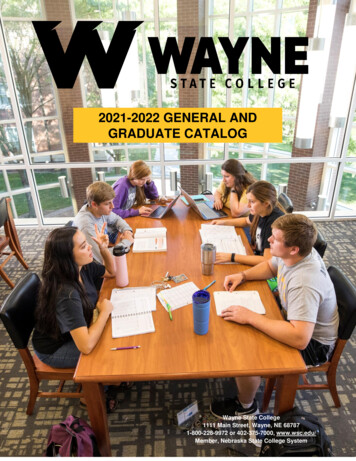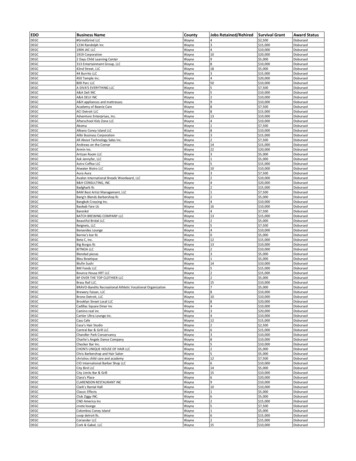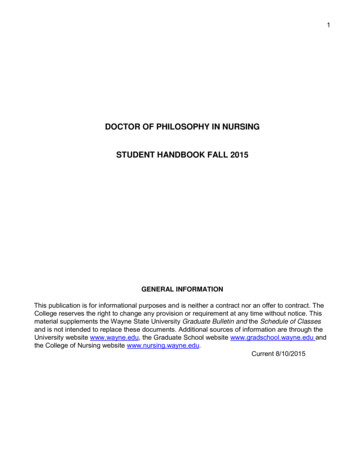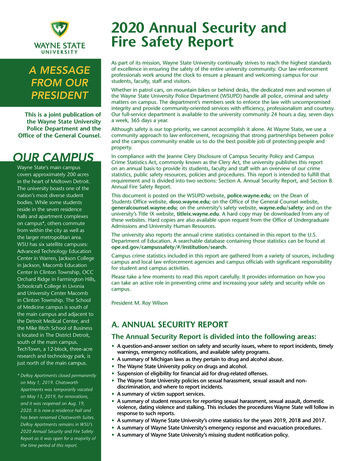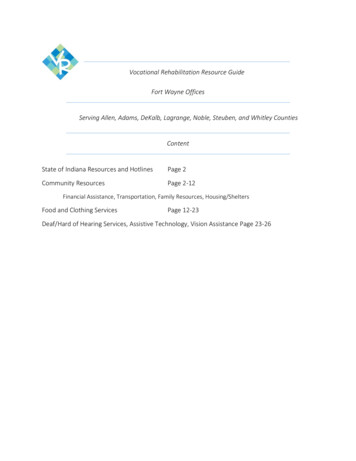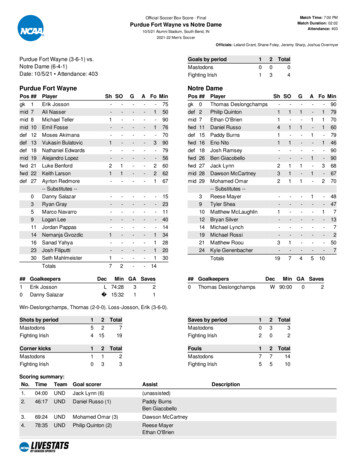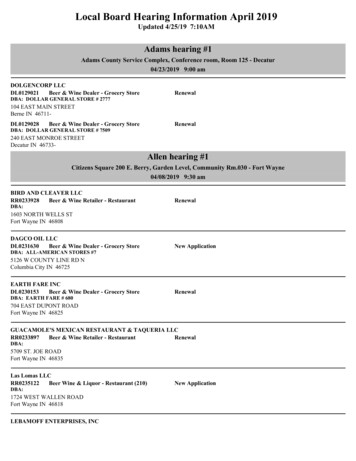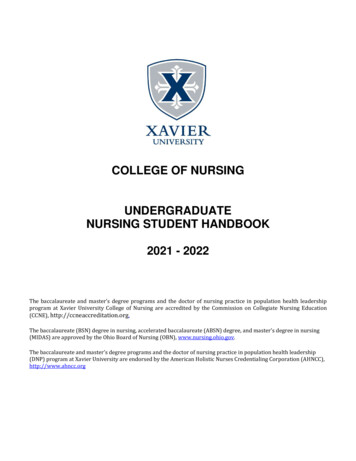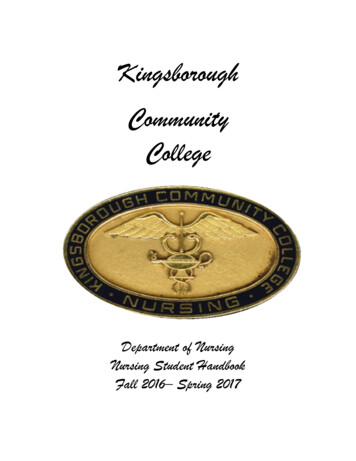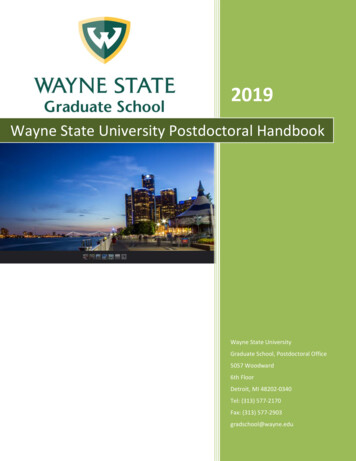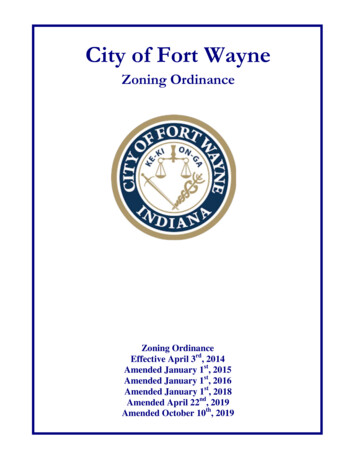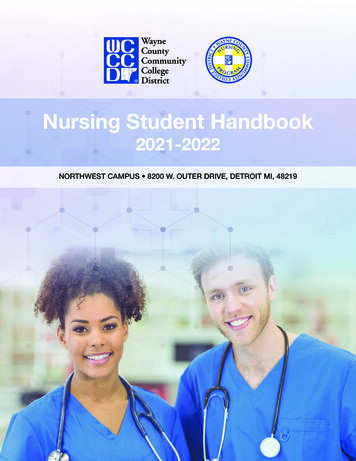
Transcription
Nursing Student Handbook2021-2022NORTHWEST CAMPUS 8200 W. OUTER DRIVE, DETROIT MI, 48219
NursingStudentHandbook2021-2022
8WelcomeWelcome to the Associate of Applied Science Degree in Nursing Program at Wayne County CommunityCollege District (WCCCD). Nursing administrators, faculty and staff are pleased you have chosen WCCCDto pursue your nursing education. We are committed to assist you in accomplishing your career goals. Thenursing program is rigorous and academically challenging. However, you can be successful.Essential to your success is ongoing communication between students and faculty. Faculty will providedidactic, lab, and clinical course instruction and integrate real-world examples to expand your experiences.As adult learners, you must actively participate by arriving to each scheduled class session prepared andassume responsibility for your learning from the initial day of class to completion of the program.We expect you will have questions during the next two years. It is important to seek answers from a crediblesource to avoid unnecessary anxiety caused by second-hand information, misinterpretation, of facts andrumors. If you have a question, seek clarification by speaking to your instructor, assigned nursing mentor,or nursing administration.The Nursing Student Handbook provides information about the WCCCD Nursing Program, its mission,vision and values, curriculum, policies, and other valuable information essential for retention, progression,and graduation from the program. The Handbook is arranged by chapters for easy location and retrieval ofinformation. The Handbook is reviewed and revised annually by the Nursing Faculty.It is essential that all nursing students read this Handbook, refer to it throughout their studies, and complywith the policies it sets forth. It contains rules governing the appropriate conduct for students and theirparticipation in the classroom, clinical and related activities, as well as the policies and procedures of theNursing Program. The Handbook along with each course syllabus serve as a reference and students areexpected to review often.All students are responsible for compliance with current rules, policies, and procedures contained in theHandbook. All such rules, policies, and procedures are subject to change at any time at the discretion of theDistrict and/or Nursing Program. As revisions are made, students must comply with the updated rules,policies and procedures as they proceed toward completion of the program.Additionally, nursing students are required to comply and conduct themselves within the published rules,policies and procedures of the District, including, without limitation, the WCCCD Student Handbook,which is available at: https://www.wcccd.edu/academic/pdfs/Nursing Student Handbook 20202021 FINAL.pdfWe look forward to preparing you for entry into the nursing profession.Nursing AdministrationFaculty and StaffInformation in this Handbook describes the WCCCD Nursing Program at the time ofpublication. However, changes may occur in policies and procedures.Such changes will be disseminated prior to implementation.i
WAYNE COUNTY COMMUNITY COLLEGE DISTRICTAssociate of Applied Science in Nursing ProgramNursing Student Handbook 2021-2022TABLE OF CONTENTSWelcome .iCHAPTER ONE: NURSING PROGRAM, MISSON, VISION, AND PHILOSOPHY . 1College Mission StatementCollege Vision StatementCollege ValuesNursing Program MissionNursing Program GoalEnd of Program ValuesEnd of Program Student Learning OutcomesNursing Program StandardsNursing Program Conceptual ModelSystematic Plan for Evaluation (SPE)CHAPTER TWO: NURSING PROGRAM CURRICULUM.4Educational TheoryLength of Nursing ProgramCredit/Clock Hours TableCurriculumNursing Course DescriptionsEssential Functions Related to the Profession of NursingMotor AbilityAbility to CommunicateAbility to Problem-SolveAbility to Maintain Emotional StabilityAbility to Perform if Taking Prescribed MedicationCHAPTER THREE: NURSING PROGRAM LEARNING ENVIRONMENTS &REQUIREMENTS .11Learning Environment ConductElectronic DevicesTheory SettingClinical Practice SettingsSocial MediaSimulation LabSimulation ProcessPre-briefingDebriefingEvaluationPage ii
8WCCCD Nursing Skill/Simulation Lab GuidelinesEquipment Use in the Simulation LabGeneral Care & MaintenanceSupplies & InventoryStandard PrecautionsSimulation Days AttendanceConductConfidentialityStudent EvaluationsPhotography and Video Recording Use PolicyClassroom Learning EnvironmentTheory Classroom Dress CodeClinical Practice Learning EnvironmentClinical Dress CodeStudent Employment ParametersAttendance/Tardiness PolicyAbsence Due to Jury DutyOrientation to Clinical SiteWhere to ReportTransportation to Assigned Clinical Placement SiteClinical ResponsibilitiesPatient SafetyLatex Allergy and SensitivityAlliance for Clinical Experience (ACE) and Program RequirementsOnline EducationWCCCD/ACE Nursing Program RequirementsPhysical ExaminationImmunizationsBasic Life Support (BLS)Criminal Background CheckUrine Drug ScreenCHAPTER FOUR: STUDENT PROGRESSION IN NURSNG PROGRAM . . .23Profile of the Successful Nursing StudentEvaluation of ProgressGrading ScaleQuestions about Exam and Assignment GradesRequesting Final Course Grade ChangesAcademic ProgressionLapse in EnrollmentLeave of AbsenceWithdrawal from Nursing (NUR) CourseTheory Course Failure and Remediation ProgramSecond NUR Course Failure or Withdrawal from Nursing (NUR) CourseCollege-Wide Re-entry Committee Role and ResponsibilitiesThird NUR Course Failure or Withdrawal from Nursing (NUR) CourseDeparture from Nursing ProgramIII
8CHAPTER FIVE: EXAM AND QUIZ GUIDELINES . . .28Exam and Quiz GuidelinesExam and Quiz Make-UpExam and Quiz ReviewMath Exam PolicyCHAPTER SIX: ACADEMIC SUPPORT . . .30Nursing Program Mentoring ProgramMentoring Program OutcomesEarly and Often Program and Documentation of Unsafe PracticeStandardized Testing: Self-Directed Coaching and Enhancement Program MultiLearning Lab (MLL)Learning Resource Center (LRC)ACCESSCHAPTER SEVEN: COMMUNICATION . .36CommunicationInformation on File in the Nursing Office Surveysand QuestionnairesCHAPTER EIGHT: GUIDELINES AND POLICIES .37Medication AdministrationMedication Administration ProcedureViolation of PolicyDrug and Alcohol Testing PolicyCHAPTER NINE: ETHICS, CIVILITY, AND BEHAVIOR STANDARDS . .42Student Code of Conduct ViolationsCHAPTER TEN: GRADUATION PROCEDURES AND REQUIREMENTS . .44Nursing Pinning Ceremony Application for Degree Graduation with HonorsCHAPTER ELEVEN: REGISTERED NURSE LICENSURE .45Application for Registered Nurse LicensureRequest for Testing Modification on Licensure ExaminationIV
WAYNE COUNTY COMMUNITY COLLEGE DISTRICTAssociate of Applied Science in Nursing ProgramNursing Student Handbook 2021-2022CHAPTER ONE: NURSING PROGRAM MISSION, VISION, AND PHILOSOPHYThis section describes the mission, vision and values which guide Wayne County Community CollegeDistrict (WCCCD) and the Nursing Program.College Mission StatementWayne County Community College District’s mission is to empower individuals, businesses andcommunities to achieve their higher education and career advancement goals through excellent accessible,culturally diverse, and globally competitive programs and services.College Vision StatementWayne County Community College District will be known as a premier community college and innovator inthe areas of high quality academic and career education, talent development in support of regional economicgrowth, diversity and inclusion, and technological advancement.College Values1. Supporting Excellence in Teaching and Learning: We value excellence in teaching and learning; weenable students to achieve desired learning outcomes through individual attention and varied approachesto teaching. Our programs and courses are designed for students from all backgrounds in an effort to helpthem achieve academic and career success.2. Honoring Diversity: We value and celebrate the multi-cultural, gender, generational, socio-economicstatus and experiential global understanding of our students and others we serve. We nurture increasedappreciation and understanding of diverse cultures, ideas and ways of thinking needed to live asresponsible citizens in a global society.3. Serving the Common Good: We value being a student-centered and community-based communitycollege. We provide a caring, friendly, responsive, safe and accessible learning environment for students.We are an integral part of the communities we serve, providing community services that improve theeconomic, social, cultural and educational life of these communities.4. Being Accountable: We are accountable to the students who depend on us to provide them with a qualityeducation, to the citizens who support us with their tax dollars and to the businesses that depend on us toprovide them with highly trained employees. We commit to being good stewards of the resources that areprovided to us and to being accountable for creating a positive learning environment that producesstudent knowledge and skills.5. Operating with Integrity: We exemplify the values of honesty, trust, fairness, reliability and mutualrespect in every aspect of our work.The Nursing Program at WCCCD offers an Associate of Applied Science Degree in Nursing. Programrequirements include specific courses in the nursing major and general education. The Nursing Program isdesigned to prepare graduates to provide nursing care as staff nurses in a variety of health care settings.Graduates of the Nursing Program are eligible to complete the National Council Licensure Examination forRegistered Nurses (NCLEX-RN).1
8The Nursing Program’s mission and vision statements are aligned with the core values and strategic goalsand objectives of the College. The Nursing Program embraces the same values as the College. Additionally,Nursing Program faculty affirms these statements:Nursing Program MissionThe mission of the WCCCD nursing program is to educate, prepare and empower student nurses to becomecompetent registered nurses who exemplify professional practice in a compassionate caring manner. Theprogram strives for excellence using best practice standards that promotes the health and wellness ofindividuals, families, groups, and communities in a culturally diverse society.Nursing Program GoalThe goal of the Nursing Program is to produce accountable, adaptable generalist who is prepared tosuccessfully complete the NCLEX-RN exam and function as registered nurses in diverse care settings.Nursing Program Concepts1. Professional nursing practice2. Best practice3. Caring and diversity4. ExcellenceEnd of Program Student Learning Outcomes1. Apply professional accountability congruent with the roles, responsibilities, and values associatedwith nursing practice.2. Integrate evidence-based principles as a foundation for nursing practice.3. Demonstrate effective patient centered care to diverse populations in a variety of care environments.4. Examine care standards with continuous scrutiny for the betterment of individuals, families, groups,and communitiesACEN Accreditation: The Nursing Program earned initial accreditation by the Accreditation Commissionon Education (ACEN) in a decision letter dated April 23, 2021.Nursing Program StandardsProfessional standards and competencies for the nursing program are derived from:1. Accreditation Commission on Education in Nursing (ACEN) https://www.acenursing.org/acen-home/.2. American Nurses Association (ANA) Standards of Practice and Professional .org/ana/about-ana/standards/3. The National League for Nursing (NLN) Education Competencies( r-core-competency);NLN Core Values http://www.nln.org/about/core-values andNLN Integrating Concepts ams/competencies-fornursing-education) ;4. Michigan Board of Nursing( https://www.michigan.gov/lara/0,4601,7-15489334 72600 72603 27529 27542---,00.html );5. The National Council for State Boards of Nursing (NCSBN) four major client needs for NCLEX-Testplan ( https://ncsbn.org/2019 RN TestPlan-English.htm);6. Quality and Safety Education for Nurses (QSEN) initiative were utilized in the development of thecurricular directives, to include the program educational outcomes( https://qsen.org/ ).The curriculum is planned to ensure that graduates develop the essential knowledge, skills, and attitudes tomeet professional role expectations to provide safe, quality nursing care within complex healthcare systems.2
8The four major client needs are incorporated into the curriculum as they are utilized within the NCLEX-RNtest plan.Systematic Plan for Evaluation (SPE)The Systematic Plan for Evaluation assesses every aspect of WCCCD Nursing Program and consists of thefollowing Accreditation Commission for Education in Nursing (ACEN) standards:Standard 1 – Mission and Administrative CapacityStandard 2 – Faculty and StaffStandard 3 – StudentsStandard 4 – CurriculumStandard 5 – ResourcesStandard 6 – OutcomesStudents will have many opportunities to evaluate the Nursing Program and actively participate in theprogram’s systematic plan for evaluation (SPE).3
8CHAPTER TWO: NURSING PROGRAM CURRICULUMThe curriculum prepares students to achieve the outcomes of the nursing program, including safepractice in contemporary health care environments.Educational TheoryThe nursing program offers a curriculum that reflects the educational needs of the adult learner. Thecurriculum is progressive with new learning supported by content of previous nursing courses.Memorization of content is minimized as the student learns and sharpens psychomotor skills andarticulates the “why” behind the skill. Students are taught to “think like a nurse” by using nursingjudgment - critical thinking, clinical reasoning, and the integration of best evidence – to guide nursingpractice (NLN, 2012).Self-reflection is encouraged as students discover their strengths and areas for improvement, guided bynursing faculty to achieve goals. Experiential learning occurs through the varied clinical sites providedin urban and suburban settings with rich exposure to diverse economic, ethnic, and racially differentpopulations. This “real world” exposure prepares nursing students for the clients and families they willmeet.Nursing faculty consider their role as one of teacher, facilitator, evaluator, advisor, mentor, andresource person rather than a role of lecturer or grader as student gains a deeper learning of thecontent. Guiding the student to connect didactic content to the clinical setting enhances learning andachievement of the student learning course and graduate outcomes.Faculty value a learning environment that is supportive, respectful of experiences students bring tothe classroom, and emphasizes the importance of life-long learning. The concept of professionalism iswoven through the curriculum where the nurses’ role of a life-long learner is emphasized.Teaching strategies are varied and designed to meet the needs of adult learners through case studyanalyses, simulation, student self-reflection, NCLEX-RN styled questions with growing emphasis onapplication, small and large group discussion, and role play. Strategies offer a four-part approach tolearning through didactic, skills lab, clinical, and simulation targeting all types of learners includingvisual, auditory, tactile, kinesthetic, and social.The nursing faculty acknowledges the eight core competencies outlined in the document, The Scope ofPractice for Academic Nurse Educators (NLN, 2012), and endeavor to integrate the competencies indaily teaching and interactions with students.Length of Nursing ProgramThe nursing program curriculum is intended to be completed in three-years, including the prerequisite courses. Many students complete most or all of the general education courses prior tobeing admitted into the program.The required credit and contact hours for general education and nursing courses are listed in the table below(Page 5). Students should meet with a nursing advisor as needed for additional information.4
8Credit Clock Hours TableCourse Number & TitleNumberofAcademicCredits3Clinical Location Site(s)Theory/Lab/Clinical/Simulation(Contact Hours)ClassroomTheory- 45 contact hours4Classroom/LabTheory/Lab- 90 contact hours*PSY 101: Intro to Psychology*BIO 240: Anatomy & Physiology I*BIO 250: Anatomy & PhysiologyII*BIO 295: Microbiology34ClassroomClassroom/LabTheory- 45 contact hoursTheory/ Lab - 90 contact hours4Classroom/LabTheory/ Lab - 90 contact hours4Classroom/labNUR 110: Fundamentals4Classroom/Skills LabSimulation LabNUR 118: Physical Assessment2Classroom/Skills LabTheory/ Lab - 90 contact hoursTheory- 30 contact hoursSkills Lab - 85 contact hoursSimulation- 5 contact hoursTheory with embedded lab30 contact hours Lab*ENG 110/119: English 1*BIO 155: Intro to BiologyBIO 155 is a pre-requisite to BIO 240ClassroomTheory- 30 contact hoursAcute Care Hospital:4Clinical- 85 contact hoursNUR 112: Medical/Surgical IMedical-SurgicalSimulation- 5 contact hoursSimulation Lab2ClassroomTheory- 30 contact hoursNUR 119: Pharmacology3ClassroomTheory- 45 contact hours*DT 130: NutritionClassroomTheory- 22.5 contact hours3Hospital L&D/OBSkills Lab - 62.5 contact hoursNUR 114: ObstetricsSimulation LabSimulation- 5 contact hoursClassroomTheory- 30 contact hoursAcute Care Hospital:4Clinical- 85 contact hoursNUR 116: Medical/Surgical IICardiac/RespiratorySimulation-5 contact hoursSimulation Lab3ClassroomTheory- 45 contact hours*SOC 100: Intro to SociologyClassroomTheory- 22.5 contact hoursInpatient3Skills Lab - 62.5 contact hoursNUR 210: Mental HealthPsychiatric/CommunitySimulation-5 contact hoursSimulation LabClassroomTheory- 30 contact hoursAcute Care Hospital:Clinical- 85 contact hours4NUR 212: Medical/Surgical IIIGI/GUSimulation- 5 contact hoursSimulation Lab3ClassroomTheory- 45 contact hours*ENG 120: English II3ClassroomTheory- 45 contact hours*PS 101: Political ScienceClassroomInpatientTheory- 22.5 contact hours3Pediatric/CommunitySkills Lab - 62.5 contact hoursNUR 214: PediatricsHealth/SchoolSimulation: 5 contact hoursSimulation LabClassroomTheory- 30 contact hoursAcute Care Hospital:4Clinical- 85 contact hoursNUR 216: Medical/Surgical IVRehabilitation/NeurologySimulation-5 contact hoursSimulation Lab2ClassroomTheory- 30 contact hoursNUR 218: Issues and Transitions34 Gen Ed Course Credit Hours 35 Nursing Credit Hours 69 Total Nursing Credit Hours527.5 Nursing Clinical 85 Skills Lab 35 Simulation Total Nursing Hours 647.55
8PRE-REQUISITE COURSESCOURSECOURSE TITLECREDITENG 119English I3 CreditsBIO 255*Introduction to Biology4 CreditsBIO 240Human Anatomy & Physiology I4 CreditsBIO 250Human Anatomy & Physiology II4 CreditsBIO 295Microbiology3 CreditsPSY 101Introduction to Psychology4 Credits*BIO 155 is a pre-requisite to BIO 240.Pre-requisite Total: 22 Credit HoursSEMESTER ONE – FIRST 7.5 WEEKSNUR 110NUR 118Nursing FoundationsPhysical Assessment4 Credits2 CreditsSEMESTER ONE – SECOND 7.5 WEEKSNUR 112NUR 119Medical-Surgical I – Theory & ClinicalPharmacology4 Credits2 CreditsSemester One Total: 12 Credit HoursSEMESTER TWODT 130NUR 114NUR 116Introduction to Nutrition3 CreditsObstetrical Theory & Clinical3 CreditsMedical-Surgical II – Theory & Clinical (Half-Semester)4 CreditsSemester Two Total: 10 Credit HoursSEMESTER THREESOC 100NUR 210NUR 212Sociology3 CreditsPsychiatric Nursing Theory & Clinical3 CreditsMedical-Surgical III Theory & Clinical (Half-Semester)Semester Three Total: 10 Credit HoursSEMESTER FOURNUR 214NUR 216NUR 218Pediatrics Theory & ClinicalMedical-Surgical IV Theory & Clinical (Half-Semester)Nursing Issues, Transitions, & LeadershipSemester Four Total:3 Credits4 Credits2 Credits9 Credit HoursCOLLEGE DEGREE REQUIRED COURSESPS 101ENG 120American GovernmentEnglish Composition II3 Credits3 CreditsNURSING PROGRAM TOTAL: 69 Credit Hours6
8Course/SemesterTakenCourse DescriptionNUR 110NursingFoundationsSemester 1This course provides an introduction to the nursing profession including history, standards ofpractice, legal and ethical issues, nursing process, and foundational nursing skills. Anemphasis is placed on the roles and responsibilities of the nurse as a caregiver. Students willapply the skills learned a supervised laboratory practicum to develop care for patients intoday’s changing health care environment.NUR 118PhysicalAssessmentSemester 1This course focuses on the nursing knowledge necessary to perform and document a physicalassessment. Common conditions and deviations of physical assessment are identified.Students apply the nursing process and demonstrate assessment skills in a supervisedlaboratory practicum.NUR 112MedicalSurgicalNursing ISemester 1This course focuses on the application of the nursing process to the care of the adult patientexperiencing medical-surgical health conditions in a variety of health care settings. Evidencebased practice is integrated to provide the student with current trends to better facilitate thedevelopment of clinical reasoning skills. Content includes cultural and psychosocialinfluences in the care of diverse patient populations.NUR 119PharmacologySemester 1This course examines the nursing process for managing the pharmacological care of the patientin today’s changing health care environment. It explores safe medication administration witha focus on medication drug classification, concepts, and principles. Dosage calculations forsafe medication administration are also incorporated. An emphasis is on the nursing student asa caregiver and the responsibility involved administration of medications.NUR 114ObstetricNursingSemester 2This course focuses on the application of the nursing process to the care of obstetric patient,the newborn, and the family unit in a variety of health care settings. The course also exploreswomen’s health across the life span. Emphasis is on the nursing student as a caregiver and theresponsibilities this entails related to women’s health. Use of evidence-based practice isintegrated to provide the student with current trends to better facilitate the development ofclinical reasoning skills. Content includes a focus on cultural and psychosocial influences inthe care of diverse populations.NUR 116MedicalSurgicalNursing IISemester 2This course is a continuation of Medical-Surgical Nursing I with application of the nursingprocess in the care of the patient experiencing health-illness conditions in a variety of healthcare settings. Evidence-based practice is integrated to provide the student with current trendsto apply in clinical reasoning. Emphasis is on the nursing student as a caregiver and theresponsibilities this entails. Content includes a focus on cultural and psychosocial influencesin the care of diverse patient populations.NUR 210PsychiatricNursingSemester 3This course introduces the student to the dynamics of human behavior during psychiatricillness. Principles and concepts of mental health, mental health interventions, andtherapeutic environments are explored. Use of evidence-based practice is integrated toprovide the student with current trends to better facilitate the development of clinicalreasoning skills. Student skills in the application of the nursing process are sharpened inmanaging care of the diverse psychiatric patient.7
8NUR 212MedicalSurgicalNursing IIISemester 3This course is a continuation of Medical-Surgical Nursing II with application of the nursingprocess in the care of the patient experiencing health-illness conditions in a variety of healthcare settings. Use of evidence-based practice is integrated to provide the student with currenttrends to apply in clinical reasoning. Emphasis is on the nursing student evolving into therole of professional nurse and the responsibilities this entails. The student’s application ofthe nursing process is enhanced in managing care of the adult patient.NUR214PediatricNursingSemester 4This course focuses on the nursing care of the pediatric patient and family unit. The conceptsof growth and development related to the pediatric patient will be examined. Use ofevidence-based practice is integrated to provide the student with current trends to apply inclinical reasoning. An emphasis is on the nursing student evolving into the role of theprofessional nurse and the responsibilities this entails. The student’s application of thenursing process is enhanced in managing care of the pediatric patient and family.NUR216MedicalSurgicalNursing IVSemester ter 4This course is a continuation of Medical-Surgical Nursing III with application of the nursingprocess in the care of the patient experiencing health-illness conditions in a variety of healthcare settings. Use of evidence-based practice is integrated to provide the student with currenttrends to apply in clinical reasoning. Emphasis is on the nursing student evolving into therole of professional nurse and the responsibilities this entails. The student’s application ofthe nursing process is enhanced in managing care of the adult patient.This course focuses on the successful transition of the graduate student nurse into safeclinical practice as a professional nurse. This course prepares students with the necessaryNCLEX preparatory skills. It also highlights management and leadership issues impactinghealth care today. Emphasis is on the student evolving into the role of professional nursewith responsibility for prioritizing nursing actions and judgments related to the delivery ofsafe and effective patient care.8
8Essential Functions Related to the Profession of NursingStudents in the nursing program must demonstrate the ability to perform specific cognitive functionsand demonstrate psychomotor skills in order to succeed in the profession of nursing. Nursing studentsmust possess the ability to perform all functions (to the level of 100%) that are necessary components ofthe Nursing Program.The Campus Dean or designee and Student Services will determine what reasonable accommodationsmay be provided for students with disabilities and will complete an accommodation letter that will begiven to the Dean of Nursing and Campus Dean.Listed below are the Essential Functions of a Nursing Student at WCCCD. Please review carefully. It is the student’s responsibility to notify the Nursing Program of any disability impactingthe ability to perform the essential functions prior to entering Nursing Program. It is the student’s responsibility to inform Nursing Administration of any change in healthstatus that impacts the ability to perform the essential functions as the student progresses inthe nursing program. Students must be able to perform all functions without restrictions. If a student cannot completethe required functions, it is the student’s responsibility to contact Nursing Administration todiscuss options.This list of Essential Functions is not all inclusive: Visual acuity with corrective lenses to identify color changes in skin, respiratory movementin patients; read fine print/writing on physician’s orders, monitors, equipment calibrations,measure medications in syringes, administering medications, assessing wound status, readingcharts/flow sheets, reading thermometers, IV’s, etc. Hearing ability with auditory aids to hear monitor alarms, emergency signals, call bells,telephone orders; hear blood pressure, heart, lung and abdominal sounds with astethoscope; to understand a normal speaking voice without viewing the speaker’s face,converse with client, families and staff from various distances with varying audible sounds. Tactile ability to feel differences in skin temperature and to perform physicalassessment, performing palpation, giving injections, starting IV’s, sterile and nonsterile dressing changes, urinary catheterization, assess skin temperature and texture,and assist with patient care activities.Motor AbilityPhysical ability to walk long distances, to walk independently, to stand for prolonged periods, toperform CPR, ng/pulling/dragging/climbing, tolift, move, and transfer patients/equipment of 20 lbs. or more, to maneuver in limited space, toprovide routine and emergency care, to have manual dexterity and feeling ability of hands to inserttubes, prepare medications, and perform technical skills.Ability to CommunicateAbility to communicate effectively in English in verbal and written form through interaction withclients, family, and healthcare members from a variety of social, emotional, cultural, and intellectual9
8backgrounds; to write clearly and correctly on patient’s record for legal documentation, able tocommunicate the patient’s response to therapy to other members of the health care team, followspontaneous verbal and written instructions, consult with health care team members/workers in aprofessional manner.Ability to Problem-SolveIntellectual and conceptual ability to think critically in order to make decisions, which includesmeasuring, calculating, reasoning, analyzing, prioritizing and synthesizing data; competent assessmentof a client in a timely manner, and correctly interpreting assessment data, readily responding withappropriate nursing/medical interventions and treatment plans, can work independently for positivepatient outcome.Ability to Maintain Emotional StabilityAbility to function safely under highly stressful situations and adapt to change
Simulation Lab Simulation Process Pre-briefing Debriefing Evaluation . 8 III WCCCD Nursing Skill/Simulation Lab Guidelines Equipment Use in the Simulation Lab General Care & Maintenance Supplies & Inventory Standard Precautions Simulation Days Attendance Conduct Confidentiality Student Evaluations Photography and Video Recording Use Policy
